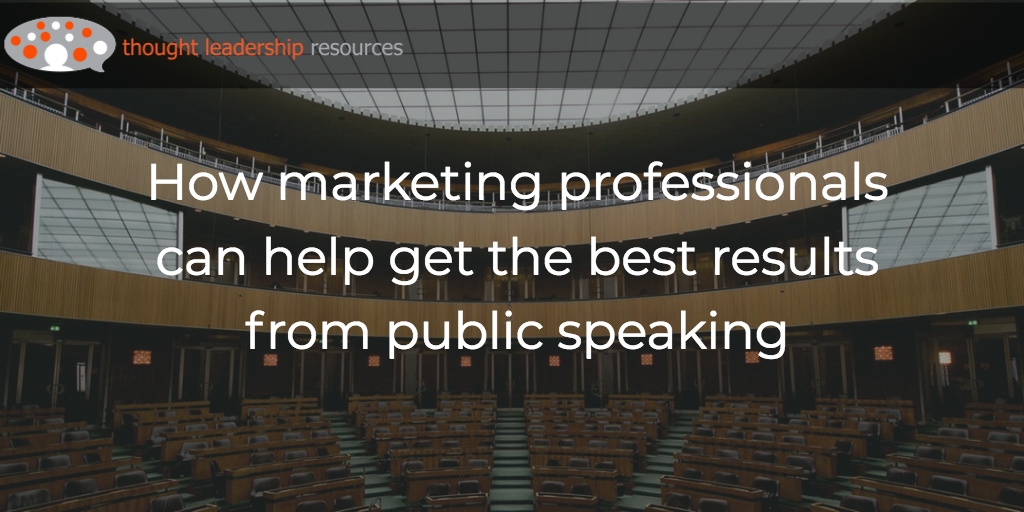Have you ever arranged for one of your firm’s members to give a presentation at a conference, but it seemed to be a dud from a business-development perspective?
Sure, the speaker agreed to do the gig. Then they show up at the office after the event, reporting that the speech occurred and as far as they can tell, it was well received. But they can’t tell for sure about the audience reaction because they left the event right after the end of the speech.
And you’re left frustrated. They didn’t talk with anyone before the event or afterwards, even though such conversations are particularly powerful for starting new relationships with potential clients. They didn’t collect any business cards for later follow-up. As far as you can tell, the speech had no business development benefits.
Public speaking can be an amazing business development tool – but that involves more than just the speech itself. For more on the "benefits that public speaking provides that nothing else does", see my earlier post here.
For this post, I thought I’d dig into some of the steps that marketers can take to help their Client Service Professionals (CSPs) get the best possible benefit from public speaking. This includes three kinds of tasks: (1) those that the marketer can do; (2) those that marketers can support their CSP in doing; and (3) those that the CSP must do themselves.
Things marketers can do
In some ways, actually doing the speech is not the most powerful aspect of public speaking. The power lies in the credibility that the speaker gains from being invited to do the speech. So, the marketer can build maximum publicity before and after the speech.
My LinkedIn news feed is full of evidence that many marketers “get it” and are publicizing the speeches their members give. Sometimes, this is a notification ahead of time, or it could be a post-event note. It doesn’t really matter – just having the speaking opportunity confers credibility, so bragging about it works.
Twitter is another good way to promote a speech before or after, maybe with a link to more information about it.
Many of the social media postings I see – mostly LinkedIn, Twitter and sometimes Facebook – are from the firm’s profile on these platforms, not the profile of the speaker.
Marketers can also provide guidance on the topic of the speech. Many CSPs want their speech to focus on an area they are interested in themselves – some evidence of their extreme cleverness, perhaps, in a case study. Meeting organizers and meeting attendees, by contrast, prefer to attend speeches on topics they want to know about – generally, especially thorny problems they’re facing. Marketers can help to make sure that the speech topics are oriented around real issues that your firm’s ideal clients are concerned about.
Marketers can also provide guidance around which venue to speak at. Some CSPs would rather speak at meetings of their peers. That works if they get a lot of referral work from people in their peer group. But more likely, the CSP needs to reach audiences that are in a different industry, with different professional backgrounds. So, as a marketing professional you can find the audiences that contain potential clients and then steer the CSP towards those.
Marketers can also make sure that the speaker’s slides are informative but not so dense that they distract from the message. Sometimes, using commercially-available templates can be a good way to boost the credibility of the information while not over-crowding the screen. Venngage has some good ideas in their post, “7 tips for designing a persuasive presentation.”
Things marketers can support speakers about
Some speech-maximizing steps are those that the speaker needs to do for themselves, but the marketer can provide support to make sure things get done, and done right.
This includes drafting summaries of the speech suitable for social media. The speaker can then post that text on their LinkedIn profile, and maybe insert it into a few of the groups in which they participate.
Also, consider re-purposing of the content of the speech. That could mean taking portions of the text and re-purposing them as blog posts, or articles. The marketer could also have the presentation re-done as a webinar, in which the presenter talks through the presentation at their desk, using a microphone.
Things that the speakers have to do themselves
(but you can still help make it happen)
Then, there are some aspects of getting the most from speaking, which the CSP needs to do on their own, although marketers can push it along.
The first challenge you may face is simply getting your firm’s CSPs interested in doing presentations in the first place. I find that many senior technical people are eager to do presentations at professional conferences, but are less interested in talking at events that are actually attended by potential clients. So, it may be necessary for you to help them adapt the ideas in their conference presentations so that they are suitable for an industry event.
You can also coach your CSPs in networking, so that when they do presentations, they’re more inclined to use those events as the start of a professional relationship. But it’s still up to them to reach out and make the networking happen.
There are a lot of benefits to public speaking, and marketers can do a great deal towards helping those benefits happen for their firm.


